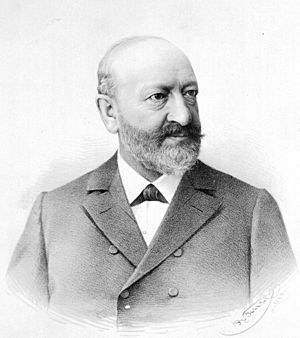Julius Wiesner facts for kids
Dr. Julius Ritter von Wiesner (born January 20, 1838 – died October 9, 1916) was an important professor who studied plants at the University of Vienna. He was an expert in how plants work (their physiology) and what they are made of inside (their anatomy).
Who Was Julius Wiesner?
Julius Wiesner was a brilliant scientist who spent his life learning about plants. He helped us understand how plants grow, move, and make their own food.
A Life Dedicated to Plants
In 1870, Julius Wiesner became a professor at a special school for forestry in Mariabrunn. Later, from 1873 to 1909, he taught about plant anatomy and physiology at the University of Vienna. He also taught about plant materials at the Vienna University of Technology.
He was so dedicated that he started the first department focused on plant physiology at the University of Vienna in 1873. This was a big step forward for plant science!
Julius Wiesner was also an adventurer. He traveled all over the world to study plants in different places. He went on scientific trips to countries like Egypt, India, and Java. He also explored Sumatra, North America, and even the cold Arctic.
Amazing Plant Discoveries
Julius Wiesner's research helped us understand many things about plants. He studied how plants move towards light, which is called phototropism. Think about how a sunflower turns to face the sun – that's phototropism!
He also investigated how plants make chlorophyll, the green stuff that helps them turn sunlight into energy. Plus, he looked into the useful properties of plant materials, like how they could be used for different technologies.
His work was so important that even famous scientists like Charles Darwin read and discussed his book about how plants move. To honor his contributions, a type of plant was named after him: Wiesneria.
See also
 In Spanish: Julius Wiesner para niños
In Spanish: Julius Wiesner para niños


